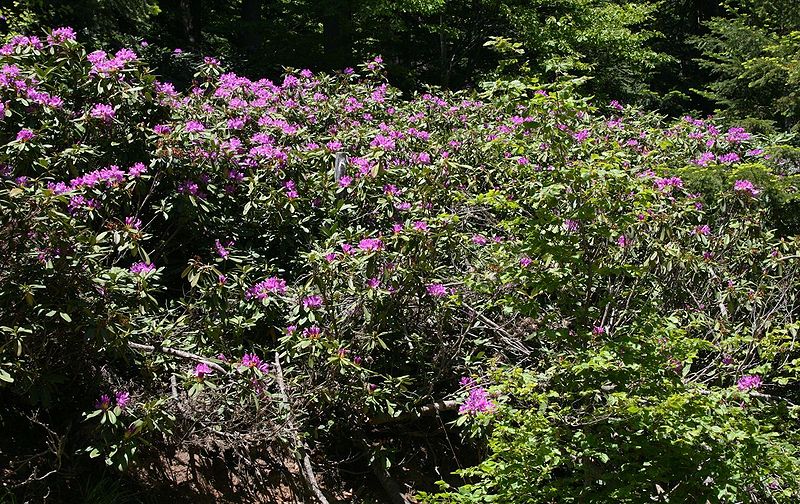Adaptation
Growth
Rhododendron ponticum can grow up to ten
meters in height and can have a substantial amount of growth
laterally. The lateral growth essentially allows the plant to 'jump'
over obstacles where the roots cannot grow. For example,
the roots will become established on one side of a stream, lateral
growth will take place over the stream, and roots will then
establish on the other side.
These adaptations increase the plants surface area
enabling it to reach more sunlight and simultaneously blocking
sunlight from other organisms.
©Franz Xaver 2008
Mycorrhiza
Forming a
mutualistic relationship with mycorrhiza is a
great adaptation. The mycorrhiza is increasing the surface area of
Rhododendron ponticum's roots; therefore, allowing it to
gain more nutrients. This gives Rhododendron ponticum a
competitive edge over plants without mycorrhiza in its roots.
Toxins
Potentially toxic chemicals are present in substantial
amounts in Rhododendron ponticum. Due to these toxic
chemicals,
the plant is unpalatable to predators such as herbivores,
omnivores, and some insects. To learn more about the toxins
present in Rhododendron ponticum,
click here.
Seeds
When Rhododendron ponticum seeds are dispersed into an
area that is not suitable for growth, they can be dormant for several years. If the conditions become favorable for growth within
those several years, the viable seed can become a plant.
growth within
those several years, the viable seed can become a plant.
Leaves
When Rhododendron ponticum is mature, the leaves
become physically tough. This is an added defense against herbivores
and other organisms that may try to feed on the leaves of
Rhododendron ponticum. They also have a waxy coating to prevent
desertification.
©Design for unity
Leaf buds
When leaf buds are forming, small invertebrates may try to
feed on them. To deter this, there is a sticky exudate which will
trap any of these invertebrates.
 Rhododendron ponticum is also a successful invasive
plant for other reasons. It can withstand somewhat harsh
habitats and it is a good
competitor. Rhododendron ponticum can form very thick bushes, depleting
sunlight and water from other organisms around them.
Rhododendron ponticum is also a successful invasive
plant for other reasons. It can withstand somewhat harsh
habitats and it is a good
competitor. Rhododendron ponticum can form very thick bushes, depleting
sunlight and water from other organisms around them.
Much of Europe is experiencing a problem with the
invasion of Rhododendron ponticum. Rhododendron
ponticum is
typically the better competitor in comparison to native species in
the same ecological niche. To learn more about the invasion,
click here.
©National Trust Images/David Levenson
.jpg)